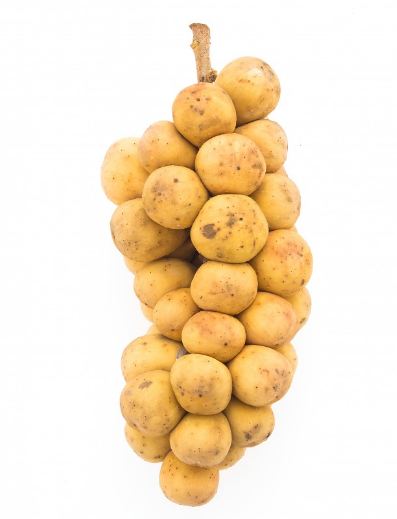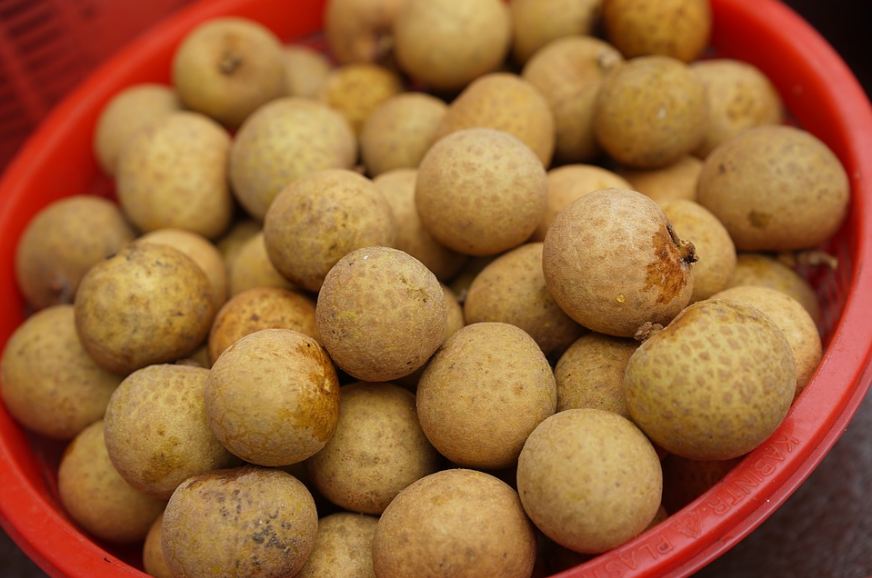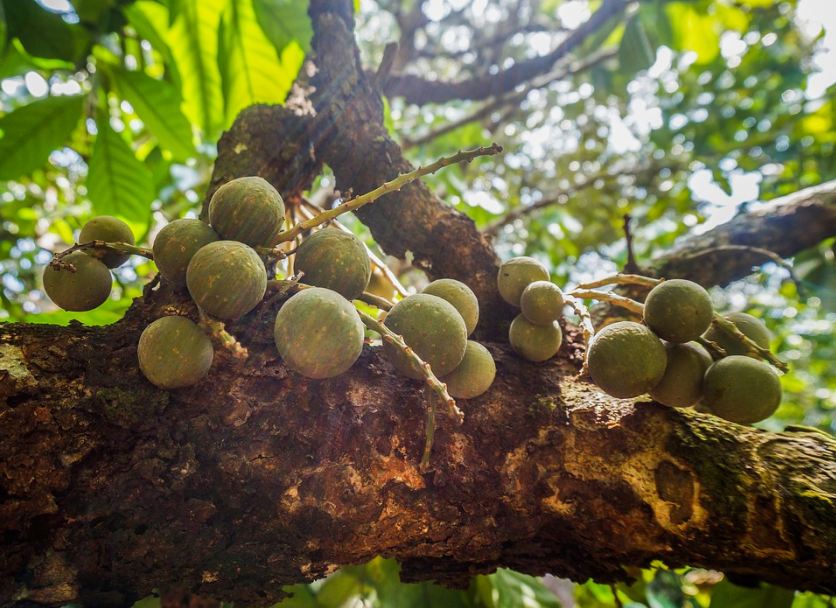Langsat, taxonomically known as Lansiumparasiticum, is a species of fruit-carrying trees in the family Meliaceae. Native to Southeast Asia, this species is famous for its bright sweet-tangy tropical fruit. It is mainly cultivated in Malaysia, the Philippines, Malaysia, Indonesia, Thailand, India, and Brunei. It is also commonly referred to as lanzones and longkong in English and as duku and dokong in the Malay Peninsula.
Growing a langsat tree is a laborious process that requires a lot of patience. It takes the tree many trees to bear fruit; however, the result is worthwhile. There are many different varieties of Langsat commercially cultivated for their fruit. The exotic fruit of the Langsat tree is a tropical delight for many fruit-lovers worldwide. Other than its piquant taste, langsats are also prized for containing an abundance of nutrients. You can eat them raw; however, they also make a palatable addition to fruit cocktails.
Keep reading this article to know everything about Langsats, from their various varieties to growing tips.
Description of Langsat
The Langsat tree features an average-sized, erect trunk that can reach a height of thirty meters and a width of seventy-five centimeters. It grows in a rather peculiar way, showcasing its buttress roots above ground. The furrowed bark ranges in color between the red and brown spectrum, with light and dark spots throughout its length. It has a thick and milky resin.
The tree’s dark-green leaves are elliptic-oblong or ovate with pointed ends and a prominent midrib. They have a slightly leathery glossy upper surface but a duller lower surface. They are about seven to twenty cm long, usually grow in odd numbers, and arrange themselves in a pinnate formation. The pinnation is around nine to twenty inches in length, with about six to seven alternate leaflets. The leaves’ stems measure about five to twelve millimeters in length.
The dainty white-yellow flowers usually grow in hairy clusters that hang down from the trunk or the oldest branches. These furry racemes are ten to thirty cm in length and branched at the base with bisexual fleshy flowers.
The fruit is an oval or ovoid-oblong berry that is two to five cm in width. It has a velvety leathery skin covered by thin yellow furs and contains milky latex. The thickness of the fruit’s skin varies in cultivars, ranging from two to six millimeters. The unripe fruit is dull green, which ripens to a golden-yellow or pale-brown color. It resembles small potatoes in appearance and grows in clusters similar to grapes.
The berry contains about one to three seeds enclosed by a thick, clear-white aril. They are flat, brown-green in hue, two to three cm long, and one to two cm wide. They are bitter in taste and stick to the flesh, which may result in a bitter flesh.
Varieties of Langsat
There are several cultivars of Lansiumparasiticum available in the market. Different cultivars have different characteristics; however, all these varieties can be classified into two main groups: pubescens and domesticum. Trees in both groups show a wide range of diversity in size, shape, and taste. Each group has its characteristic attributes that complement different needs.
Wild Langsat

Duku
Var. domesticum, typically called duku or doekoe in the Malay Peninsula, features a sturdy spreading tree with a densely foliaged crown and short bunches of fruit. The dense crown flaunts bright green leaves with conspicuous veins. The fruit in this group is larger and more round than that in Wild Langsat. It has an ellipsoid or oblong-ovoid shape with thick skin enclosing it. The hardy skin is faintly fragrant and does not release sap on cooking as it is void of any milky latex. The fruit’s seeds are small in size and enveloped in a thick flesh. They have a distinct sweet smell and a sour flavor. Cultivars in this group thrive in tropical climates. A popular choice in Duku is Du 1 from Malaysia.
How to Grow Langsat
Propagation
- Growing a langsat tree is labor-intensive and can prove strenuous if one is not familiar with gardening. However, with our detailed guide, this laborious task will be made easy. Follow the steps listed below to grow a robust langsat tree and enjoy its succulent fruit:
- You can propagate a langsat tree from the seeds of its fruit. The first step is to find a langsat tree that yields healthy and delicious fruit and extract one such fruit from it. Once you have acquired a healthy fruit, cut it, and take out the green seeds. In case you can not find a langsat fruit, you can buy the seeds from a conservatory or order them online. Ensure that you extract the largest ones as the larger the seeds, the greater the seedling vigor. Langsat seeds are recalcitrant, so you must sow them as soon as you extract them. If you leave them out for more than a week, they will dry out and not germinate.
- Next, clean the seeds. Run the fruit seeds under cold water to remove the sticky substance around them.
- Once the seeds are clean and dry, it is time to sow them in the prepared soil. To prepare the ground, dig small holes approximately one inch in depth. Ensure the holes are at least one to two inches apart to accommodate future growth. Bury the seeds in these holes and backfill them with soil. Langsat seeds thrive in a moderately fertile loamy soil with a neutral to slightly acidic pH. Feed the prepared soil with some organic matter and compost to nourish it before sowing.
- The langsat plant enjoys basking in the sunlight, so for sowing the seeds, choose a spot that receives ample sunlight. The seeds require fifteen hours of daylight every day to germinate. If planting indoors, get a light lamp with an alarm or place your pot near a window.
- The germinating seeds need well-drained soil with moderate levels of moisture to flourish. Therefore, water your seeds every day with a watering can and ensure the soil is moist. However, you should not flood it either, so keep a check on the amount of water you are adding to your soil.
- It will take about fourteen to twenty days for the seeds to germinate and for you to see some baby stalks growing out of the soil. However, to plant these seedlings outside, you will have to wait at least ten to eighteen months. Once the seedling has reached the size of a pencil, it is ready for planting outside.
Planting
- For planting the Langsat tree, the most significant step is to ensure whether the climate of your region will promote its growth or not. Langsat trees are best suited to ultra-tropical climates, so if you live in hardiness zone 11 or greater, your tree will thrive!
- Young Langsat trees prefer well-drained sandy-loamy soil in a shaded area. They do not enjoy facing direct sunlight, so ensure you plant them in a place with enough shade. Slightly acidic soil will promote their growth; however, high alkaline levels will inhibit it.
- Once you have prepared the soil, dig holes fifty cm in depth and width. The hole should be deep enough to cover the roots of your Langsat tree. When planting more than one tree, ensure there is a distance of at least ten meters between each digging. Failure to do so will lead to overcrowding and stunted growth.
- Failure to do so will lead to overcrowding and stunted growth.
- Before planting the seedling, backfill the hole with some soil and a 6-6-6 fertilizer. This step ensures that your tree receives enough nutrients for healthy growth.
- Next, plant the seedling and fill the hole with soil. Once it is covered, add some extra soil on the top and press it with your hands to fix the seedling in its position.
- The final step is the hardest. You have to take good care of your Langsat tree and wait about ten to fifteen years to enjoy its bearings!
The Takeaway
Like all the good things in life, growing a Langsat tree also demands patience and effort on your part. Although it is quite laborsome, the delicious fruit is worth every second of effort. So, do not wait anymore! Get your gardening gear out and plant Langsat seeds in a pot today!


